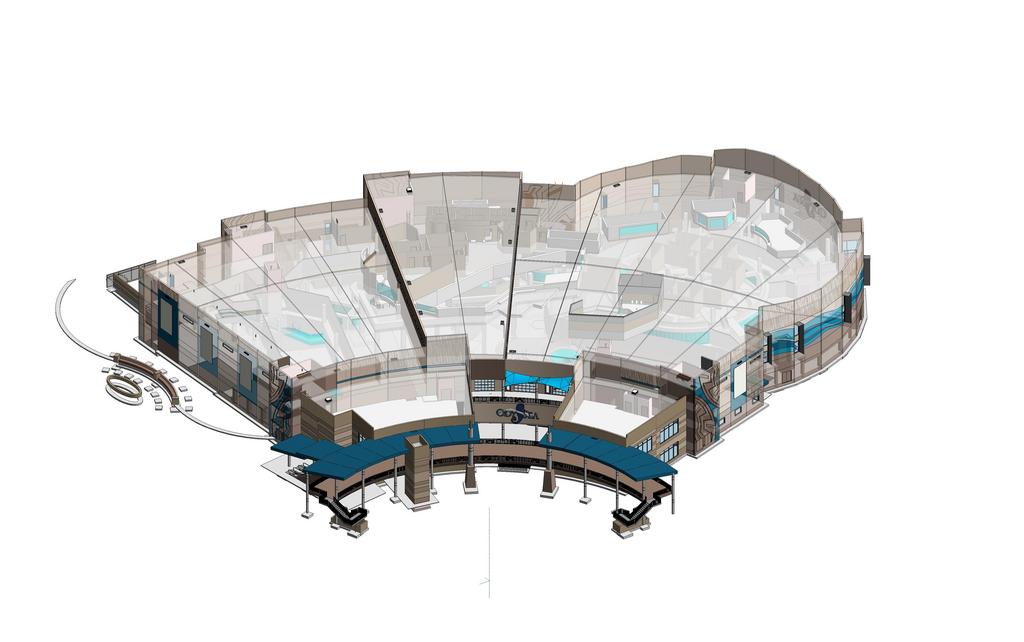By Enrique Sarmiento | Phoenix Business Journal
Facility owners are increasingly favoring the use of design coordination services, particularly when a project has highly complex systems such as the OdySea Aquarium, a new world-class attraction being built in Scottsdale, Arizona.
Virtual design and construction (VDC) enables successful preconstruction and construction planning efforts by providing for the identification and resolution of potential issues early in a project’s lifecycle, plus delivering concise information during construction.

Tools such as electronic plan rooms; 3D, 4D, and 5D modeling; tablet-based building information modeling (BIM) software; QR equipment coding; and robotic total stations allow for virtual construction and streamlining the most complex construction projects.
“Using advanced VDC technology, we virtually incorporated more than a mile of underground piping, intricate life-support systems, and a building design that features rounded walls and aquariums,” said Jim Brandt, project director of general contractor McCarthy Building Cos. “Modeling this out virtually allowed our teams to identify and resolve issues before a single shovel went into the ground.”
Advance design coordination involves three major phases of work on construction projects: preconstruction collaboration, design review modeling, and construction modeling.
Pre-construction collaboration
When a project owner opts for design coordination, the general contractor, architect, engineer and owner begin working together to achieve the owner’s vision early in the process.
Preconstruction collaboration impacts decisions ranging from procurement of materials to scheduling of trades and everything in between. When the team is integrated from the beginning, a construction project becomes less segmented and more united, which renders a positive impact on the overall project, its timeline and costs.
Design review modeling
With design coordination, a 3D design review model is developed based on 2D drawings submitted by engineers and architects. By beginning to model the project with only 30 percent of the design completed, clashes are detected much sooner, which greatly reduces problems in the field, ultimately saving time and money.
Due to its complexity, the OdySea Aquarium owners determined that design coordination made sense for such an ambitious project, which is expected to be completed next summer.
When building the design review model, numerous clashes were detected with drawings for the life support systems and aquatic equipment, and plans for the concrete footings used to support the vast aquarium structures and columns. Furthermore, the plumbing lines also interfered with the layout of the aquatic systems.
By detecting this during design review modeling, the team developed a solution – excavating at three different levels for construction sequencing – that was the most cost effective for the owner.
Construction modeling
In this phase, the construction model becomes an as-built plan for the project. It provides the owners with a tool to see their vision come to life. The facility’s end users gain a better understanding of the plans, and sometimes changes can be implemented based on feedback.
At OdySea, the team members were able to have a virtual visitor experience that ensured the design and layout were exactly how they want guests to see and experience the tanks and exhibits.
“When changes are needed, the as-built allows us to work with an owner to make adjustments prior to construction begins and avoid major changes that in the past have delayed completion and added significant costs. It’s a very valuable tool,” Brandt said.
Operations and maintenance personnel also reap the benefits of design coordination because information such as equipment manuals, manufacturer specifications, and other important details are embedded into the model. By simply using a tablet and accessing the model, they can quickly pull up important equipment information as well as perform and track routine maintenance or troubleshoot, as needed.
The enhanced collaboration and productivity of construction projects provided by VDC is allowing for better buildings and a better community experience.










